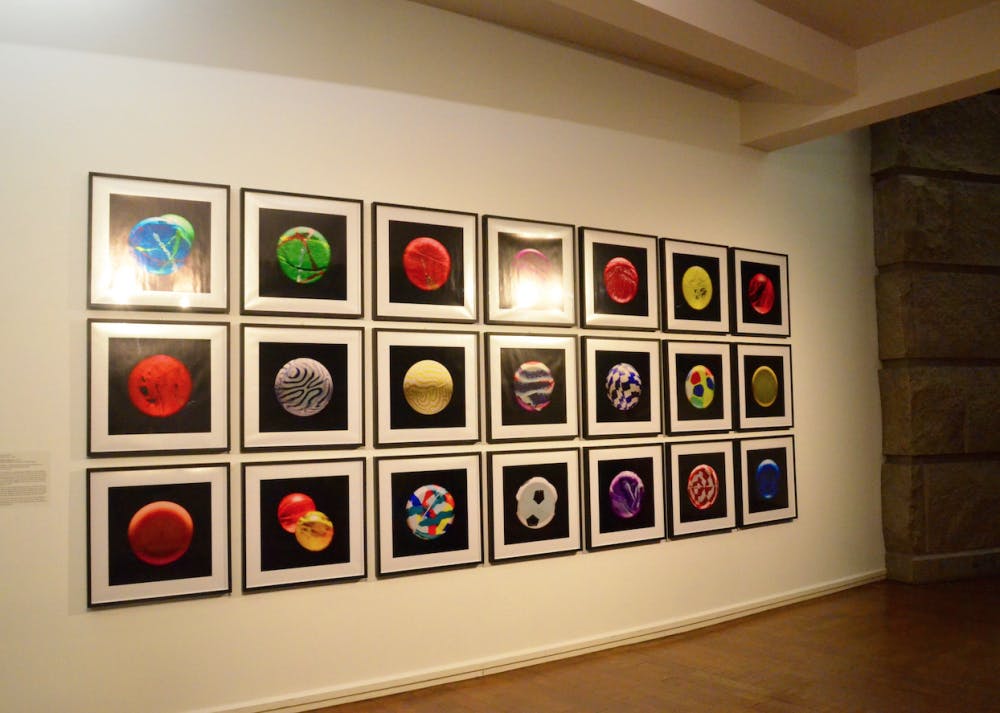On the eve of Commencement 1985, a student crept into the meadow where McCardell Bicentennial Hall stands today, took a blowtorch to a tall, boxy sculpture and burned it.
The sculpture, a four-sided closet-sized metal building with panels of six playing cards on one side and an entrance door painted with flags of six countries on the other, was never meant to be so provocative. Vito Acconci, who was the Christian A. Johnson Distinguished Visiting Professor of Studio Art at the time, built the structure — titled Way Station I (Study Chamber) — with the help of students in his Winter Term class in 1983. It was intended to “offer a quiet space for refuge and contemplation,” according to the Committee for Art in Public Places.
Despite this placid intention, the structure sparked fierce objections from the student body in 1983 and 1984.
Angry students complained of both the structure’s aesthetic and its location. One student called it “a tool shed intended to withstand the apocalypse.” Another told The Campus that he was starting a petition to advocate for the removal of the sculpture because he found it “to be very poorly built and I see no aesthetic value in it whatsoever.” Four times the sculpture had to be repainted because of graffiti.
And then, there was the burning.
For Director of the Art Museum and current Chair of the Committee for Art in Public Places Richard Saunders, the destruction of Way Station I (Study Chamber), one of the College’s only pieces of public art at the time, was alarming.
“I thought it was shocking, personally, that at a liberal arts college that has one its underpinnings as a belief in free speech that a group of people could destroy something that had been commissioned by the College,” said Saunders.
Saunders was charged by President of the College Olin Clyde Robison to clean up the controversy surrounding Way Station I (Study Chamber). Saunders’ subsequent work to bring the artist back to the College for discussions and restore the structure produced the idea behind the Committee for Art in Public Places (CAPP): Saunders, along with Middlebury sculptor Eric Nelson, decided that the best way to reintroduce Way Station I (Study Chamber) to the College was in the context of more public art.
In 1994, after many years of informal efforts by Saunders and others to bring more public art to the College, the Committee for Art in Public Places was formally established and the College adopted a “One Percent for Art” policy. This policy set aside one percent of the cost of any renovation or new construction project at the College with a budget of one million dollars or more for the purchasing and maintenance of public art installations.
As a result, Middlebury College is one of the few small colleges in the U.S. with such an extensive campus-wide sculpture collection and a formal commitment to the promotion of public art.
Today, CAPP has brought over twenty new pieces of public art to the College. The committee also refurbished Way Station I (Study Chamber) in 2013, relocating it to a more secluded spot east of the Mahaney Center for the Arts.
CAPP is composed of a board of faculty, students, administrators and trustees of the College who evaluate proposed donated art works and purchases and prioritize prospective sites for future projects. Over time, CAPP hopes to make its collection more inclusive and diverse in terms of artists’ gender, ethnicity and nationality.
Just this fall, CAPP unveiled its newest addition to the collection, Chaos Xaxis, which was donated to the College by an anonymous donor. Chaos Xaxis stands 14 feet tall and is located between the Axinn Center for Starr Library and Route 7.
Despite these goals and developments, however, CAPP finds itself in a curious state of limbo. In 2009, the “One Percent for Art” policy was suspended by former president Ron Liebowitz due to financial struggles following the 2008 market recession. The Board of Trustees ordered CAPP to stop purchasing new works and to use their endowment only for the maintenance of current art or the installation of donated art.
Saunders is hopeful that with a new president may come the return of the “One Percent for Art” policy.
President Laurie L. Patton commended the unveiling of the Chaos Xaxis sculpture in September 2015.
“We are thrilled to have this prominent sculpture find a permanent home on the Middlebury campus,” she said. As of now, Patton has made no formal statements about her thoughts on reinstating the “One Percent for Art” policy.
Saunders hopes the College’s commitment to public art continues because public art promotes thoughtful conversation on a college campus.
“What we need to do is to have this campus art collection be an opportunity for a dialogue and an exchange of ideas and just becoming aware,” said Saunders. “We need to be at least working in the direction of visual literacy.”
Shannon Hutteman ’16, an art history and economics double major who is one of the student members of CAPP, also believes that public art is part of the College’s educational experience.
“The public art displayed in our buildings brings a depth to our everyday learning environment, whether it be for learning or simply the pleasure of viewing,” said Hutteman. “Art can command our attention in ways that allow us to pause and reflect on what we see, and perhaps on a deeper level, learn what our perceptions of said works tell us about ourselves.”
Rising from the Ashes: How the College’s Public Art Policy Emerged from a Violent Act of Vandalism

Comments


